READER COMMENTS ON
"Results of Close Busby/Bilbray U.S. House Special Election in Doubt!"
(95 Responses so far...)
COMMENT #1 [Permalink]
...
big dan
said on 6/7/2006 @ 2:36 pm PT...
If Bilbray wins 51%-49%, there should be a riot!!!
Bush 51%-Kerry 49%.
Schmidt 51%-Hackett 49%.
Casey is ahead double-digits in Pa. in pre-election polls. That means, on e-vote machines, Santorum 51%-Casey 49%.
If Bilbray wins 51%-49%, people should march on the streets. The will of the people is being undermined. We can't get these people out of office with controlled e-vote machines.
COMMENT #2 [Permalink]
...
big dan
said on 6/7/2006 @ 2:38 pm PT...
Anyone taking any bets on "Bilbray 51%-Busby 49%"????????????????????
COMMENT #3 [Permalink]
...
Savantster
said on 6/7/2006 @ 2:45 pm PT...
heh.. pRicky! here ya go! You win again because Brad is pointing out that "security measures" were crap and these "easily hackable machines" could well have been hacked in an important election!
Of course, you LOSE because we all LOSE when the "will of the people" is thwarted by EITHER SIDE..
But then, we already know you don't care about "right or wrong", you only care about "winning".. you make that abundantly clear every time you snear "my party is in control! suck on that! you suxorz!"..
Not to worry.. some day you'll get hair down there, the zits will stop popping up like wildfire, and your voice will stop cracking. Then you can come to the adult table and talk with us.
COMMENT #4 [Permalink]
...
robin Gibson
said on 6/7/2006 @ 2:52 pm PT...
I would gladly volunteer to help recount for free. Let's get rid of the big money they always charge and have volunteer citizens recount all of it.
COMMENT #5 [Permalink]
...
MrBlueSky
said on 6/7/2006 @ 2:53 pm PT...
Brad:
Have you been in contact with the Busby campaign? Does she plan on disputing the results?
That was the whole problem with the Kerry 2004 campaign... you and bloggers like you around the world (literally!) built the case for vote machine fraud but Mr. Kerry never made the challenge.
COMMENT #6 [Permalink]
...
Old Turk ---- SEND BRAD $$$$$$$$ !!!!!
said on 6/7/2006 @ 3:15 pm PT...
Very well written Brad,..
Democracy is being thrown in to the nearest
trash dumpster,.. should we not do something
about this ?
Democracy was a "Quaint Concept"
that out lived it's usefulness,.. don't needlessly
devote wasted energies worrying about this,.. we
should just move on,..
Is this the recommended approach
that should be taken to deal with this atrocity ?
Don't worry,.. be happy,.. FASCISM is not a bad as
you may think.
WAKE UP AMERICA !
COMMENT #7 [Permalink]
...
bvac
said on 6/7/2006 @ 3:31 pm PT...
There was some video thing on CNN by some pundit whose name I don't remember about how all of the recent elections have been very close, but always favoring Republicans even when they weren't expected to. It went over the 2000, 2002, 2004, and 2005 elections highlighting the victories of Schmidt over Hackett and Bilbray over Busby. It seemed to spot the trend and I thought he might've mentioned election shenannigans, but at the end he just posited the idea that the Republicans are God's party and ended the segment. CNN - the most reliable source for news and information... in the WORLD.
COMMENT #8 [Permalink]
...
labdad
said on 6/7/2006 @ 3:35 pm PT...
So, what can we do to get rid of these frickin' machines?
COMMENT #9 [Permalink]
...
Harry
said on 6/7/2006 @ 4:06 pm PT...
Don't understand. The State of CAlifornia SOS records shows that Busby had 9000+ more votes than Bilbray with 100% of Precincts reporting. Did Bilbray make up that difference in the absentee ballots?
I think a manual re-count is in order. Something is very wrong here. Busby should not conceed.
COMMENT #10 [Permalink]
...
Patrick Dodd
said on 6/7/2006 @ 4:12 pm PT...
We need to pass referendums making the machines illegal, mandating exit polling, ...
COMMENT #11 [Permalink]
...
bvac
said on 6/7/2006 @ 4:19 pm PT...
Harry: Those are the results from the primaries. Yesterday's election came out 60319 - 55587 for Bilbray (allegedly).
COMMENT #12 [Permalink]
...
Floridiot
said on 6/7/2006 @ 4:23 pm PT...
Bvac, that is 51% to 49%....HOLY SHIT !!!! (again)
COMMENT #13 [Permalink]
...
Patrick Dodd
said on 6/7/2006 @ 4:24 pm PT...
COMMENT #14 [Permalink]
...
john
said on 6/7/2006 @ 4:24 pm PT...
Fascism in America STARTED in 1980.
http://fuller.mit.edu/pe...gan_hostage_19910415.htm
An Open Letter to the United States Congress From Former American Hostages in Iran (June 13, 1991)
For the last ten years there have been rumors, reports and allegations of foul play in the 1980 presidential election. The thought that any American, whether a private citizen or government official, may have participated in delaying release of the hostages for political gain is distressing.
The question of whether there is evidence of any wrongdoing must be answered by an unbiased, bipartisan congressional investigation with full subpoena power. Unless this happens, speculation and unanswered questions will erode public confidence in our electoral system.
Respectfully,
Charles W. Scott, Barry Rosen, Moorhead Kennedy, Jerry Plotkin, David M. Roeder, Robert C. Ode, Kevin J. Hermening, Donald R. Hohman.
COMMENT #15 [Permalink]
...
Patrick Dodd
said on 6/7/2006 @ 4:25 pm PT...
COMMENT #16 [Permalink]
...
Pam
said on 6/7/2006 @ 4:39 pm PT...
Yes, sleepovers for voting machines. I was interviewed on our local news station about it prior to the election.
The procedure is that certain pollworkers are assigned equipment to take home with them upon receiving their training. They then bring it to the polling place on election morning early, and set up. Depending when they have training the machines could be at their homes for more than a week or two.
For this June primary, the DREs were essentially there just for disabled voters. There was no encouragement to use them. My polling place had two DREs, one set up with the audio / accessibility module, and the other basically in use for the purpose of programming (encoding) the voter cards in case anyone had to use the (other) DRE. Both were equipped with VVPAT printers, as is the law in CA. (A tech-savvy pollworker I spoke to lamented the flimsy design, saying surely they could have done better...)
However, the story is that November's election will be all-DRE. Despite that plan, I suspect that San Diego will never be without paper ballots in the polling place (not after the March 2004 fiasco, when thousands of voters were disenfranchised by machine malfunctions causing late opening of polling places, and no paper ballots available for emergencies) again. But will there be enough, if voters ASK for them? Possibly not.
Best,
Pam
VerifiedVoting.org
COMMENT #17 [Permalink]
...
Diane
said on 6/7/2006 @ 4:41 pm PT...
I called Busby's headquarters in Cardif. It didn't seem like they'd read Brad Blog today.They were in the middle of a staff meeting but I was able to briefly mention the handling of the Diebold machines and said I was sorry she conceded so quickley.
Is there any recourse now? Someone needs to talk to them. Busby must speak out !!!
COMMENT #18 [Permalink]
...
Nunyabiz
said on 6/7/2006 @ 4:43 pm PT...
I think every single democrat should DEMAND a hand recount on every election.
If Busby concedes even though she knows perfectly well the extreme likelihood of voter fraud then she deserves to lose, just like Kerry.
Kerry literally fell all over himself getting to the podium to concede because he couldn't get there fast enough.
It was disgusting to watch.
Every single Democrat should make it a point to not concede until a full hand count is taken.
COMMENT #19 [Permalink]
...
Floridiot
said on 6/7/2006 @ 4:47 pm PT...
John, I agree totally If Cheney would only do a death bed confession (I think hes already dead though)
The only way the Pukes could ever have gotten into power is through a coup of sorts, and that was it right there in your post
COMMENT #20 [Permalink]
...
Em Aitch
said on 6/7/2006 @ 4:48 pm PT...
What I emailed to the DCCC. (A note of background info: They're always saturating my inbox with requests for money. So far I haven't budged)
Is anyone paying attention? The California's 50th district used DIEBOLD voting machines!! There might have been tampering--no one has any way of knowing for sure!! If you have one molecule of true blue democrat lurking anywhere in your body(ies), you will insist with Francine Busby that the result MUST Be challenged.
Please don't escape this opportunity to cause a ruckus!! Please remind us everyday working family democrats why the DCCC is something I should contribute money to. A campaign on behalf of Francine Busby would help nudge me closer and closer to my check book...
For more information, please consult www.bradblog.com. He states the case for challenging the election results very plainly.
Sincerely,
COMMENT #21 [Permalink]
...
Charlie L
said on 6/7/2006 @ 4:55 pm PT...
If Busby doesn't ask for a review of the number of provisional ballots that were declared "spoiled" and perhaps a hand-recount of some of the pricints, then she can NOT expect to be supported again.
Democrats get only ONE chance to show that they will fight for our votes to be counted --- after that, they are TOAST.
No "keeping your powder dry" or as we call it now "doing a Kerry."
BUSBY DEMAND A FULL ACCOUNTING OR GO TO HELL!!!!
Charlie L
Portland, OR
Check your records, you'll find my out-of-state $25 donation. MAKE GOOD ON IT NOW!!!
COMMENT #22 [Permalink]
...
sam samson
said on 6/7/2006 @ 5:04 pm PT...
Gee whiz, there sure have been a lot a close elections lately. . .
I guess it must be because the public is so evenly divided over the issues. . .
Uh huh
COMMENT #23 [Permalink]
...
Roger
said on 6/7/2006 @ 5:51 pm PT...
Did anyone notice on Lou Dobbs that he questioned the integrity of elections because of the Sequoia machines but not the Diebold machines and in the same broadcast from tonight (6-7) accepted the election results between Bilbray and Busby without a peep? I've been watching Dobbs for a while now because he seems to be the only one on MSM that has any outrage at the behavior of our government but please. Why doesn't he mention Diebold and their BS?
COMMENT #24 [Permalink]
...
calipendence
said on 6/7/2006 @ 5:54 pm PT...
I voted yesterday for two elections that were unopposed in "nonpartisan" races with Republicans running (Bonnie Dumanis and Larry McCallister). Someone had earlier posed the idea of writing in "Paper Ballots Only" to make them protest votes. I thought that was a cool idea, and then right before the election, and I'd wished I'd thought earlier about this, that perhaps if enough of us were to vote this way it would force a hand recount of all of the scanned ballots, so that if any of them were being doctored for Busby's race, it would be seen by those counting all of our "write-in"s. When looking at some websites showing voter totals, I was seeing Bonnie Dumanis and Mcallister as showing up with 100% of the vote. I asked, how could that be, since I voted a write-in against both of them. I sent an email back to San Diego County Registrar of voters (who ran this site) and got the following response back (below).
I wonder if given her response of needing to "register" write-in candidates, if we should try to register pseudo "write-in" candidates in the fall for "paper ballots only". Hopefully the process of "registering" a write-in doesn't require them to be a real person. Kinda takes away our ability to do protest votes doesn't it. Even if we have to have a person that we put on the ballot. If there's some way we can trigger a hand recount of the overall ballots by doing this in one of the races, that might serve as insurance against finaggling these optically scanned ballots in the future. Not sure what the thresshold is for write-ins. Obviously that had to have been crossed when Donna Frye "won" with her write-in count earlier in the mayoral race back in 2004. Those circumstances might be hard to recreate, but if the thresshold was some smaller attainable percentage of the vote in some race, perhaps we could force the issue that way.
From Barbara.Walther@sdcounty.ca.gov Wed Jun 07 22:22:57 2006
Subject: RE: How come write-in vote totals aren't shown in the vote totals here.
Were they counted?
Date: Wed, 7 Jun 2006 15:22:53 -0700
From: "CSG, ROVMAIL"
To: (me)
Hi Mr. (me),
To be a qualified write-in candidate a person had to file papers with our office between April 10 and May 23. In San Diego County there were only 3 qualified write-in candidates, Paul Martens, an Independent in
the Special Run-off election for the 50th Congressional District, Barbara H. Mead, a Democrat for the 38th Sate Senate and Judith E. Jones, a Democrat for the 73rd Assembly District. If you wrote in any other names they were not counted. The write-in vote counts will be part of the official certified results. By law we have until July 4 to certify the election, but we hope to be done by June 30. Let me know if I can help you with anything else.
Sincerely,
Barbara Walther
Registrar of Voters
858-694-3405
-----Original Message-----
From: (me)
Sent: Wednesday, June 07, 2006 11:48 AM
To: CSG, ROVMAIL
Subject: How come write-in vote totals aren't shown in the vote totals
here. Were they counted?
I see many unopposed candidates with "100% of the vote" and raw vote totals for them. But where do those who put write-in votes in those races fall in those totals. Are they counted in that 100%
incorrectly or are they just "left off"? I think the public is owed a line that says something like
"Write-ins "
as a line in each of the races. Not doing so makes many like myself who voted write-in votes wonder if all of our votes were thrown out because we had write-ins on our ballot.
Please explain the policy if you would and how they are factored in.
Thanks,
(me)
COMMENT #25 [Permalink]
...
epppie
said on 6/7/2006 @ 6:06 pm PT...
And there's no way to check, is there, with electronic voting.
COMMENT #26 [Permalink]
...
Truth Seeker
said on 6/7/2006 @ 6:07 pm PT...
Republicans are defeating Democrats because:
1. They are waging elections as wars.
2. They are playing to the ignorance of the masses.
3. They are willing to lie.
4. They are willing to cheat.
5. They are financing campaigns by giving tax breaks to their supporters.
I am proud to be a Democrat fully supporting the efforts of Brad and others to expose the lies and crimes.
COMMENT #27 [Permalink]
...
anonymous patriot
said on 6/7/2006 @ 6:15 pm PT...
Too late to be nice, folks. The Republicans stole the last two presidential elections, and god knows how many congressional tilts in 2002 and 2004.
Time to stop paying taxes (can't arrest us all - well, maybe they can), armor up and smash a few things, like maybe voting machines or a random election commissioner.
The fascist party has already won. They own the federal government and the machines we supposedly vote on. The only way this ends is bloody. Check history.
If that's too much for you to stand, if you're non-violent and think the Republicans can be rationed with, then hunker down and wait for the gestapo. They'll be surely in your neighborhood before, during and after the '06 elections.
Yes, I'm saying that '06 is a fait accompli, a done deal already. If, after 02 and 04, you still think Democrats can win elections farily, you have a very short memory.
We're way over the edge here in America. Time to change things or, try this new phrase: Love it and Leave it.
Other countries look a lot better about now.
COMMENT #28 [Permalink]
...
Madam Moth
said on 6/7/2006 @ 7:04 pm PT...
You libbies never fail to amuse the world with your hilarious "hurdy gurdy monkey act". 
COMMENT #29 [Permalink]
...
Steve
said on 6/7/2006 @ 7:13 pm PT...
Looks like we need to hire the best hackers in the world. Play there game the same way. Alls fair in love and war.
COMMENT #30 [Permalink]
...
Albert G
said on 6/7/2006 @ 8:11 pm PT...
Why can't you write as clearly as you spoke on Randy Rhodes?!!
Just say it up front. Poll workers took the machines home the night before and could have tampered with them with no way for anyone to know about it. Then give us the hoary details. Honestly, this is so important.
You're work is so important. Spell it out. Clearly. Succinctly.
COMMENT #31 [Permalink]
...
Data Pimp
said on 6/7/2006 @ 9:57 pm PT...
I posted something similar in a thread on DailyKOS right after the election, and was lambasted because I was "whining" when we should be "winning." The idea was, apparently, that all Dems need to do is stay positive, not give up, and all will be OK in Novemeber.
That's bullshit, of course, because a rigged game is a rigged game. You can't win a rigged game. You can smile all you want, put your nose to the grindstone, stay positive, get a huge margin with the voters... but if the results come back against you, and there isn't a reliable paper trail, any victory becomes a defeat.
I just can't understand why the Democratic party has allowed this b.s. to go on for 2000, 2002, 2004, and now this year. Wake up you sheep.
COMMENT #32 [Permalink]
...
emlev
said on 6/7/2006 @ 10:05 pm PT...
Brad,
Am I reading this right? The announced margin of victory is 4,732 votes, but 68,500 absentee and provisional ballots have not yet been counted?
How could Busby's campaign not see that this one fact alone is enough to indicate that any reports of her losing the election are--at the very least--premature?
Provisional ballots are *much* more often given to voters of color, Democrats, voters in cities. As I understand the info, these uncounted votes are very likely to be heavily weighted for Busby.
What can you tell us about who's doing what about this so far, so that we can join or support these efforts and figure out where the else it makes sense to take action?
COMMENT #33 [Permalink]
...
SeattleDem
said on 6/7/2006 @ 10:41 pm PT...
BVAC,
It was Jeff Greenfield on CNN, he was talking about how odd it is that in all the recent close elections the victory has always gone to the Repub. I was waiting and praying for him to say the words ELECTION FRAUD (please Jeff just say it for Crist sake SAY IT). Of course he finishes the rant with "It must mean god is on their side" or some bullshit like that. Unbelievable man...
COMMENT #34 [Permalink]
...
Jody Holder
said on 6/7/2006 @ 11:05 pm PT...
San Joaquin County sent their Diebold TSx units home with poll workers on Saturday, June 2, three days prior to the election.
Worse, while there was security tape over the door holding the memory card with the election and ballot definitions on it, there was no security tape over the other PCMCIA slot that can have a wireless card, modem card, or another PCMCIA card inserted into its empty slot. In fact, that slot is designed for a wireless or modem card to be inserted into it. Behind that same door is the power switch. McPherson's own Certification, as one of its conditions, required security tape to be over the door covering the power switch. That means the the system as used was not approved for use in California.
Additionally, the 8 standard phillips head screws holding the case on the back were not sealed or covered in any way. From the research that BlackBoxVoting.org did, we know the entire case can be removed completely bypassing all the security tape and seals. Whether overnight or three days, anyone with motivation and knowledge could have uploaded anything into these machines, including into the removable memory card holding the election and the votes.
That card is then removed and then uploaded into the main vote tabulation server. At that point anything malicious could then infect the main server and alter this election or even future elections. And from the Hursti II Report, we know it could be done in a way to be undetectable.
But of course this is all theory, unproven, because the election officials will never voluntarily let computer scientists do an independent forensic examination on an actual election. To get them to admit that there were any problems is like pulling teeth, let alone admit that an election might be compromised.
If the vendors and election officials have so much faith in their electronic voting systems they should welcome the opportunity to PROVE the systems are worthy of our trust.
It was not by accident that California's Secretary of State McPherson failed to make a "finding" in his Certification, as required by law, that these systems are "safe from fraud or manipulation". He knows they are not. Instead he shoulders the taxpayers with the need for more expensive, ineffectual "security procedures" to be implemented at the local level to compensate for the defective and high risk voting systems.
He has abdicated his duties as the chief election official of the State of California.
If anyone has any reports or knows of any failures of security procedures or voting units, please let me know. You can contact me through Brad.
COMMENT #35 [Permalink]
...
Ari
said on 6/8/2006 @ 2:47 am PT...
Hi, first of all I should say that I lived in CA-50 for 4 months, not very far from the home that "Duke" sold for a ridiculous profit to a political supporter ... the event that I believe kicked off the whole investigation into his other dealings. I tutored for some very wealthy families out there. I chatted it up with the striking grocery workers (late 2003) while we got passing comments from strike-breaking shoppers.
In short, I can say it's a very conservative area. To elect someone like Cunningham in the first place, it has to be pretty conservative. San Diego talk radio is awash with conservative blowhards. The local papers are, at best, mediocre and play into the local storyline. A candidate like Busby had a real uphill climb in any case. It was a neck-and-neck race all the way, and in the last week of the campaign Busby was slimed by claims that she was soliciting illegal immigrants to assist in her campaign ... a charge that hits home down there with a lot of people. A 49-45% loss is really not an unexpected outcome.
As far as whether each and every vote needs to be counted by hand to ensure that the election is valid, I'll say that I'm with you on the sentiment, and I believe it might be helpful to put this race to bed, but that a proper 10% recount, for example, would produce a statistical error of about +/-1% ... enough to have high confidence in the validity of the machines and the declared results.
Furthermore, if there are 68,500 uncounted absentee and provisional ballots in San Diego County, only a fraction of them would apply to the CA-50 race, given that CA-50 is one of 5 congressional districts represented in the county. It appears that CA-50 accounted for about 1/3 of the total votes cast (120,000/330,000) (note further that far more than 355,000 voters were registered in SD county ... that number probably only applies to CA-50 registrations), implying that roughly 25,000 uncounted votes were cast in the district, maybe up to 35,000 if you believe the wealthy CA-50 residents were significantly more likely to vote absentee. Running with the higher number, for those votes to make up the difference between Busby and Bilbray, they would have to come out at least 57-43% in favor of Busby ... a stretch by most measures.
I'm as disappointed by the election results as anyone, and I equally firmly believe we need more trustworthy voting systems. Probably, some noise should have been made about the Diebold machines weeks ago, when it was apparent they'd be used. However, to turn around after the fact and claim the election is invalid, wage legal battles, and scream bloody murder (as some here would do) would destroy the credibility of those who seek to make the system better. If people start to think you only make noise when the results don't turn out your way, they'll lose faith in your intentions and we'll all have to fight that much harder to bring these issues to the light.
COMMENT #36 [Permalink]
...
Dredd
said on 6/8/2006 @ 5:12 am PT...
Ari #35
Thanks for some info on the characteristics of Cal 50 and the very close election there. The GOP spent twice as much as the dems in that race, and still in a GOP fortress, and where the challenger put foot in mouth, still it was squeaky close.
The election, assuming for the moment as you do that it was valid, indicates other interesting characteristics of that district:
1) corruption is not a major issue
2) accountability is not a major issue
3) the voters are confused
4) the GOP was scared spitless
The GOP is saying their candidate won because immigration is such a big issue, as evidenced by the furor over the Dubai port scandal.
But what about the president selling military hardware factories to Dubai after finding out Americans do not like the idea?
That is back door immigration isn't it?
I mean, foreign governments running military plants that make critical military hardware parts (link here) is "letting them into our country" big time isn't it?
One time supporters of the Taliban working in sensitive weapons factories? Remember the movie Schindler's list where munitions were sabotaged? How hard would it be for terrorists to influence some of what goes on there?
The furor over virtual slave labor crossing the border to earn less than minimum wage and send some home is no more a story than a president putting unstable mid-east countries that supported the Taliban in ownership position of national security relevant munitions factories in the US.
COMMENT #37 [Permalink]
...
gtash
said on 6/8/2006 @ 5:16 am PT...
You know--demanding a recount should just be an automatic requirement of anybody running anywhere. When asked to show cause, show the evidence (now copious) that the machines used were unreliable. Then, as a matter of course, you will be denied. And then, as a matter of course, you sue as a plaintiff-with-standing. And then let the activist judges decided. It all seems so NORMAL now---I am surprised it isn't part of the Diebold sales pitch. "We sell machines that gurantee due process in courts!!! We even have Technical Support for Litigation!!!!" And think of the effect on fund-raising---not only do you raise money to put up election posters and have opinion-polls taken, you raise money for the inevitable post-election litigation. Is this a great country or what?
COMMENT #38 [Permalink]
...
big dan
said on 6/8/2006 @ 6:00 am PT...
51%-49%
We need a chart on how many 51%-49% GOP victories there have been, since e-vote machines.
This one, Bush-Kerry, Schmidt-Hackett.............
COMMENT #39 [Permalink]
...
big dan
said on 6/8/2006 @ 6:01 am PT...
Just give the GOP a 51%-49% victory, then work backwards, filling in the vote totals.
Casey is leading Santorum by as much as 20%, in the pre-election polls.
My prediction: Santorum 51%-Casey 49%.
COMMENT #40 [Permalink]
...
Brad Reader
said on 6/8/2006 @ 6:44 am PT...
if there was ever the perfect opportunity to turn this corrupt voting fraud mess around it is with Busby's race. It is a small enough sample to actually get the evidence and make the case and do everyting morally, ethically, legally possible to stand up and challenge election theft. Everything possible must be done here and now about the Busby race .... no better time to make a case for election protection than NOW with this case.
COMMENT #41 [Permalink]
...
Ronald Wieck
said on 6/8/2006 @ 6:58 am PT...
A Republican actually won in a Republican district?!?! Shocking--absolutely shocking!
Now, if the Democrat had won, that would have proved the voting was on the up-and-up.
Doesn't anyone on the left realize that whoever dreamed up this insane "strategy" of screeching about vote fraud in EVERY race the Dems lose is making your side look ridiculous?
There isn't a shred of credible evidence for Republican vote fraud in ANY of the races the left blogosphere has whined about. Nothing. Nada. Zilch.
COMMENT #42 [Permalink]
...
NeilDeal
said on 6/8/2006 @ 7:01 am PT...
Was EXIT POLLING done??
You'd think that it would be obvious that it needs to be done.
COMMENT #43 [Permalink]
...
Dredd
said on 6/8/2006 @ 7:09 am PT...
NeilDeal #42
The polling indicated an even race up to the last day.
This would be a good case for a hand count. Whether or not there are any complaints.
COMMENT #44 [Permalink]
...
MT
said on 6/8/2006 @ 7:12 am PT...
They appear to be trying to discourage us from voting.
Why do the dems in these contests concede so quickly?
Sit down, shut up, you ain't got no rights. I would really like to beat one of those Diebolds with a sledge hammer - hey, fund raising/prmo idea to raise money to get these machines outa here.
COMMENT #45 [Permalink]
...
NeilDeal
said on 6/8/2006 @ 7:24 am PT...
Ronald
Maybe since their have been case after case of Republican coruption like say, DUKE CUNNINGHAM,
and Bush's approval numbers are in the crapper,
and the UNDISPUTED FACT that these e-voting machines are easily riggable,
maybe, just maybe us on the less corrupt left that has every right to speak the fuck up, are a tad skeptical.
And we don't have a shred of evedence that vote fraud has ever happened??
Try looking up info on Katherine Harris. Seriously, really try to read the literature. Don't just assume anything. READ!
COMMENT #46 [Permalink]
...
Tom
said on 6/8/2006 @ 8:00 am PT...
Maybe none of these politicians like Kerry or Busby ever challenge this because its all one big game. They know that while today it APPEARS to some that things are rigged for the Republicans, tomorrow it will be their turn. It's an insider's game in my opinion and it all comes around. Think JFK and Chicago.
COMMENT #47 [Permalink]
...
Ricky
said on 6/8/2006 @ 8:09 am PT...
Gee election fraud in an election you lost. IM SHOCKED!!!
COMMENT #48 [Permalink]
...
molly
said on 6/8/2006 @ 8:13 am PT...
#31 Kos took Diebold money. They will ban you in a nanno second if you don't support dems. But yesterday Jerome wrote on Huffpost that if Dean called him, he would not answer the phone. Remember, Dean is the people's choice. It's getting more and more important to know. Progressives have to beat repubs. and DLC. The '04 dem. primary debates went on too long ...but one fact emerged. If you aren't a card carrying DLC, you will be hit hard by your own party.
COMMENT #49 [Permalink]
...
big dan
said on 6/8/2006 @ 8:18 am PT...
Ricky: Do YOU even find it fishy? ANOTHER 51%-49% GOP victory???
COMMENT #50 [Permalink]
...
big dan
said on 6/8/2006 @ 8:24 am PT...
Ronald Wieck: The point is, that there is a trend of GOP 51%-49% victories, in Republican precincts. What I'm thinking, is that the Dem upset the Republican in a Republican district. So, if they flipped the votes, it would be 51%-49%. They wouldn't flip it to be 80%-20%, or something ridiculous.
Schmidt/Hackett. Heavy Republican district.
Schmidt 51%-Hackett 49%.
We are NOT screaming about every Republican "supposed" victory. Don't put words in our mouths!!!
The Sununu victory in New England was very close, helped along by phone jamming. Ronald: Did we IMAGINE GOP phone jamming and disenfranchising voters??? Yeah, we're looney's...except there's a guy in jail for GOP phone jamming.
COMMENT #51 [Permalink]
...
big dan
said on 6/8/2006 @ 8:25 am PT...
If a Republican wins by a landslide in a Republican disctrict, we DO NOT scream about it.
If the trend of Republicans winning 51%-49% in Republican districts continues, WE WILL SCREAM ABOUT IT!!!!!
COMMENT #52 [Permalink]
...
big dan
said on 6/8/2006 @ 8:45 am PT...
This is from an article a few years ago:
Republican Controlled Voting Machines Hand Suprise Victories to...
Guess which party?
by voxfux
Diebold voting machines are implicated in widescale vote fraud. The last step in their conquest is complete. It will now be impossible to EVER have a fair vote again. And do you know why? Imagine if you will, trying to take a vote on a national referendum to make electronic voting machines open to public scrutiny? Just exactly what the fuck machine are you going to use to place your protest vote against - that's right - an electronic voting machine. And what do you think the outcome will be of that vote? You guessed it. The result be a resounding. "Nothing to see here, move along, EVERYONE unanimously voted that all this concern about electronic voting machines was just another "CONSPIRACY THEORY", move along.
Compare the projected results with the results as reported by the new Republican controlled machines. See for yourself the profound nature of the problem we all face.
Read what the Diebold machines have done to democracy in America.
------------------------------------------------------------
Poll by Atlanta Journal Constitution/WSB-TV of 800 likely voters
on Nov. 1 For Georgia Governor
Roy Barnes (D) 51% up 11
Sonny Perdue (R) 40%
"Official Results" from the 'Diebold Electronic Voting Machines'
on Nov. 5
Roy Barnes (D) 46%
Sonny Perdue (R) 51% up 5 - that's a 16-point pro-Bush
swing - was it magic?
----------------------------------
Poll by Atlanta Journal Constitution Nov. 1 for Georgia Senate
Max Cleland (D) 49%
up 5
Saxby Chambliss (R) 44%
"Official Results" from the 'Diebold Electronic Voting Machines'
Max Cleland (D) 46%
Saxby Chambliss 53%
up
7 - that's a 13-point pro-Bush swing - was it
magic?
----------------------------------
Poll by MSNBC/Zogby on Nov. 3 for Colorado Senate
Tom Strickland (D) 53% up 9
Wayne Allard (R) 44%
"Official Results"
Tom Strickland (D) 46%
Wayne Allard (R) 51% up 5
- that's a 14-point pro-Bush swing - was it magic?
---------------------------------
Minneapolis Star-Tribune Poll on Nov. 3 for Minnesota Senate
Walter Mondale (D) 46% up 5
Norm Coleman (R) 41%
"Official Results"
Norm Coleman (R) 50%
Walter Mondale (D) 47% up 3 that's an 8-point
pro-Bush swing - was it magic?
Did they let this one stay close because they knew MN loved Mondale?
--------------------------------
Poll by St. Louis Dispatch/Zogby on Nov. 3 for Illinois Governor
Rod Blagojevich (D) 52% up 7
Jim Ryan (R)
45%
"Official Results"
Rod Blagojevich (D) 43%
Jim Ryan (R)
44% up 1 that's an 8-point pro-Bush swing - was
it magic?
---------------------------------
Poll by Concord, NH Monitor on Nov. 3 for New Hampshire Senate
Jeanne Shaheen (D) 47% up 1
John E. Sununu (R) 46%
"Official Results"
Jeanne Shaheen (D) 47%
John E. Sununu (R) 51% up 4 that's a
5-point pro-Bush swing - was it magic?
Isn't it amazing that all six surprises went to the Republicans?
COMMENT #53 [Permalink]
...
Station Agent
said on 6/8/2006 @ 8:57 am PT...
COMMENT #54 [Permalink]
...
Ricky
said on 6/8/2006 @ 8:57 am PT...
No, its not amazing.
Its only a surprise to you people. Reps are the MAJORITY of the country. When you rely on faulty polling as an accurate sample of what the election will look like, this is what you get.
You libs like to protest everyday. Reps protest only a few days a year. Election days.
Having fun yet? I am.
COMMENT #55 [Permalink]
...
Station Agent
said on 6/8/2006 @ 9:00 am PT...
That's you rproblem Rickey. You're blind. Just follow the team. You'll convert when your leader is in a burned out bunker covered in petrol.
COMMENT #56 [Permalink]
...
Ricky
said on 6/8/2006 @ 9:02 am PT...
In addition. Remember questioning of Curtis as to why he was IGNORING the immigration issue?
HOW DO YOU THINK WE WON? He didnt ignore the issue, he went after it hard and guess what. HE WON. The polling changed almost instantly when he attacked the issue.
Your boy curtis is ignoring the issue. Guess what his fate is?
COMMENT #57 [Permalink]
...
big dan
said on 6/8/2006 @ 9:47 am PT...
There's millions more registered Dems than GOP, Ricky. You're talking out your ass again.
From USA Today:
'An estimated 201.5 million U.S. citizens age 18 or over will be
eligible to vote Nov. 2, although many are not now registered. Of
these, about 55 million are registered Republicans. About 72 million
registered Democrats.
About 42 million are registered as independents, under some other
minor party or with a "No Party" designation.'
source: USA Today
http://www.usatoday.com/...004-01-22-neuharth_x.htm
Thus, the USA Today figures indicate that of the approximately 169
million registered voters, 72 million (or 42.6%) are registered as
Democrats.
MORE MISINFORMATION FROM A RIGHTWINGER!!!
COMMENT #58 [Permalink]
...
Robert Lockwood Mills
said on 6/8/2006 @ 9:49 am PT...
Bilbray-Busby does look suspiciously like a carbon copy of Schmidt-Hackett. A supposedly safe Republican district, a special election, the Republican candidate wins 51-49, the press fills its stories with, "A near miss for the Democrats, suggesting trouble ahead for Republicans," and because the Republican was expected to win, the question of possible fraud doesn't arise.
There's no "trouble ahead" for Republicans if they can always steal elections, unless the Democrat is so far ahead that fraud would be obvious (in Pennsylvania, for example). But hard evidence is still needed, because it is possible Bilbray won 51% without cheating.
The district in question is so much like my former hometown of New Canaan (also the hometown of Ann Coulter, Paul Bremer, Ari Fleischer, Brian Williams, and Doro Bush's ex-husband). New Canaan wouldn't elect a Democrat, ever, even if the Republican were caught on tape sodomozing a German shepherd in the school cafeteria. It's all about money, corporatism, and a hatred of liberals.
COMMENT #59 [Permalink]
...
big dan
said on 6/8/2006 @ 9:49 am PT...
There's 17 million MORE registered Democrats in the United States, than registered Republicans. THAT is why they have to disenfranchise and cheat, they'd never win, otherwise.
COMMENT #60 [Permalink]
...
emlev
said on 6/8/2006 @ 10:04 am PT...
To Ari (response #35) and to those saying "sore loser" and the like:
I appreciate the info about there being three Congressional districts in SD Co. We cannot assume, however, that as-yet uncounted ballots would equally represent votes coming from Dem and Rep voters. In previous cases where there's a high-stakes race with a lot of GOP attention, failure to count votes from majority Dem precincts has been one of the methods used to tip the scales. (Ohio 2004 is a case in point, read the work of Dr. Richard Hayes Phillips.)
Also, Brad is *not* saying that he can prove election fraud. He's saying that there is no basis for confidence in the results as reported and that they must be verified. That's a very different thing.
COMMENT #61 [Permalink]
...
Charlie L
said on 6/8/2006 @ 10:06 am PT...
Here it is...
THE HONEST ELECTION CANDIDATE'S PLEDGE
1. I pledge to work hard to make sure that every citizen who votes for me has their vote counted for me.
2. I will not concede any contest I am involved in until I know that every absentee and provisional ballot has been counted.
3. I shall make sure that non-partisan exit polling is conducted.
4. If the final results of counted votes is different from the exit polling by more than the margin of error, I will demand and force a recount.
5. I shall exhaust every possible legal recourse to assure that every vote cast for me by a legal citizen is counted for me.
6. If asked to "concede" I shall respond: "Only when every vote cast for me has been counted --- to do anything less would be a violation of the Constitution."
7. If I am called a "sore loser" or a "waster of taxpayer time" I will reply that: "Democracy is never a waste of time and wanting to see Democratic Government working is never a bad cause."
We should withhold our money and volunteer time from any candidate that refused to sign this pledge or who has ever violated any part of it.
Busby claims she may run again. NOT WITH MY HELP IF SHE DOESN'T FIGHT FOR EVERY VOTE!
There are no halfway measures with crooks, thieves, liars and cheats.
Charlie L
Portland, OR
COMMENT #62 [Permalink]
...
Voter Fraud
said on 6/8/2006 @ 10:29 am PT...
When an election is that close with questionable machines being used then the challenger should demand a hand count of the paper receipts. However, the speed at which these Dems concede in the light of possible fraud is amazing. Look at John Kerry and the instant concession. I mean, what was that all about?
Do I smell the scent of the so called consulting wisdom of the 'DLC' (Democrats Loser Committee') anywhere nearby?
COMMENT #63 [Permalink]
...
big dan
said on 6/8/2006 @ 11:01 am PT...
Listen, I don't give a shit if Busby wins or not...I want confidence that I believe the outcome of elections!!!!!!!! I don't even live around there!
I AM upset, with the way Dems concede and don't fight, like the comment above.
COMMENT #64 [Permalink]
...
big dan
said on 6/8/2006 @ 11:07 am PT...
The biggest stink in a close election, was by a Republican. That guy who lost to Gregoire in Washington, dragged it through court for months. And then, the rightwingers say the Dems are sore losers! The Dems concede to quickly.
COMMENT #65 [Permalink]
...
MrBlueSky
said on 6/8/2006 @ 11:37 am PT...
The overall big picture is that politics has become way too poisoned these days.
There is room in the sandbox for neocon Republicans if they learn to share. There is room for us Progressives too.
But the Neocons never learned that.
In fact, I was talking to a Freeper a few months back. I asked him to comment on whether Republicans needed to return to that Big Tent idea of 1994... where all were accepted and approved by the GOP... including Democrats!
He asked me why should they do that. He thought there was no point or reason to do it.
He still didn't get it.
If you shut out any side from politics, then you risk a massive backlash... and that appears to be forming now against the neo cons.
I like neither the neo cons pushing everyone else out... nor the backlash that is forming.
I wish all sides could just get along.
That's why I support McCain and Guiliani. Last week's poll shows that only they are moderate and popular enough to save the GOP. No other national figure in that party even comes close to 50%... only McCain and Guiliani have a positive image and message today.
However, I couldn't care less about whether there is a D or an R behind their names. I only care about their character and what they stand for.
COMMENT #66 [Permalink]
...
calipendence
said on 6/8/2006 @ 11:59 am PT...
The Republicans are trying to milk this race for all they can get. Check out this CNS news story that is trying to distort the results and say that there was a 5% difference in the vote when the official site shows a 3.87% difference. If some of these votes were flipped by the machines, the difference could be even less than 3.87% and look a lot more ominous for the Fall than 5% sounds to all of those reading the right wing blogs...
Bilbray Defeats Busby
A big problem here in this area is that so many of the county positions that oversee our voting machines, etc. are ALL Republican. We though we had a shot to get a Democrat in for the first time in a decade on the Board of Supervisors (Richard Barrera) to help get some oversight in, but he was slimed by a endorsement mail "fraud" here, where mailers masquerading as Democratic Party endorsements were being sent out with all of the Democratic party nomination recommendations and instead of showing Barrera, they showed Ron Roberts instead. Though that race wasn't close, it is really hard to see how many people might have been falsely swayed wih that recommendation sheet. The other side is playing a lot of slimey games to win. And voting machines aren't out of the question. We should really check things, even though at this point it's hard to cry foul yet when don't yet have enough substantive info yet to do so. We did have a "parallel" election polling effort going on for the Donna Frye/Sanders election earlier last year. That forced a recount, though I'm not convinced that the samples were randomly selected as they should have been for recounting. No irregularities turned up from that recount, so we still have to be careful what we ask for and make it sound more in line with us feeling "sure" about the results, rather than accusing them of cheating without evidence yet.
COMMENT #67 [Permalink]
...
big dan
said on 6/8/2006 @ 12:24 pm PT...
The Republicans engage in "phone-jamming". There's a guy in jail for it. So, do we put it past them to disenfranchise voters via GOP-donor e-vote machines? The proof is in the pudding...and there's a Republican in jail for it. I guess we're imagining that Republican Tobin is in jail??? And the Republicans paid Tobin's court costs, and he is now a consultant for Repubican candidates.
COMMENT #68 [Permalink]
...
big dan
said on 6/8/2006 @ 12:49 pm PT...
SO, WHEN'S THE NEXT 51%-49% GOP VICTORY, IN A REPUBLICAN DISTRICT? I'm going to start making money in Vegas off of this!!!
How about us BradBloggers, research ahead of time, GOP districts that are in trouble, and start predicting 51%-49% victories for the GOP? It would make a mockery out of elections.........
COMMENT #69 [Permalink]
...
Voter Fraud
said on 6/8/2006 @ 12:54 pm PT...
I lived in S.D. North County for 10 years and I'm amazed that a Democrat came as close as they did. If ever there was a county whereby most the citizens are the beneficiaries of Bush's policies towards the rich, this county is it. I mean we're talking Del Mar, Rancho Santa Fe, Rancho Bernardo, Carlsbad. These are big money places where even the Estate Tax repeal would make a difference. However, what's disgusting and frightening are these Diebold Machines. Everyone knows they're a fraud, that they can be hacked, manipulated, and yet they keep popping up everywhere. The Dems need to battle the dying of the light with all their might instead of going quietly into the night.
COMMENT #70 [Permalink]
...
big dan
said on 6/8/2006 @ 1:05 pm PT...
COMMENT #71 [Permalink]
...
smithsfan
said on 6/8/2006 @ 1:51 pm PT...
here's a hypothetical which I am in no way suggesting or endorsing. I am simply putting it out there as an academic exercise. I wonder what would happen if someone or group of people were to somehow work it out to rig elections through the various voting machines in favor of a fictional character, or some historical figure or something. I mean, if these machines can be hacked, then surely one of the Brad Blog readers should be able to get to one of more of the machines in order to hack it , to prove that it can be hacked, and do so in a very funny way. The question is: do you think that the above hypothetical would get the mainstream media to wake up to the potential for fraud?
COMMENT #72 [Permalink]
...
Sally
said on 6/8/2006 @ 2:33 pm PT...
I think the best thing that could happen would be retroactive telephone polling of people who actually voted to see who people thought they were voting for. Just like exit polls. If results come out very skewed it would be pretty good evidence. Dem candidates who feel that the results are overwhelmingly wrong could perhaps ask university statistical departments to do the polling as a project. Or there are wealthy Dems out there who could pay for the local polling. This is probably the only way to get around this sort of thing and work out whats happening.
We need some wealthy donors now to pay for exit polling in places where results look fishy.
There are decent Dems out there who would do this I think. George Soros and many others are known for their good works defending the masses.
COMMENT #73 [Permalink]
...
mighty maximus
said on 6/8/2006 @ 3:34 pm PT...
COMMENT #74 [Permalink]
...
Kristen
said on 6/8/2006 @ 3:57 pm PT...
The honesty of voting is the root of all our freedoms. Any honest American --- Republican, Democrat or Independent --- should demand no less.
COMMENT #75 [Permalink]
...
robert campbell
said on 6/8/2006 @ 4:10 pm PT...
:angry: Read the article in Rolling Stone by Robt. Kennedy. Combine that with this article, especially the two state officials who sanctioned the entire process. WE NEED A RECOUNT
COMMENT #76 [Permalink]
...
Ari
said on 6/8/2006 @ 4:51 pm PT...
First of all, to Emlev #60, there are not 3 districts in SD county, there are 5. Also, I wasn't talking about counting votes from democratic precincts, but rather counting absentee votes and provisional votes, and I honestly have no idea whether those votes should be more likely to be Democratic than the others ... but I have no evidence to assume so. Anyway, we're not talking about Democratic precincts being unfairly targeted ... and honestly, I'm not sure how many strongly Democratic precincts there are out there. Maybe the youthful coastal areas of Cardiff and Encinitas are majority liberal, but they certainly aren't like a Berkeley or a Manhattan. If I had to guess, I'd say almost all the precincts in the district are between 45%-65% conservative ... no super strongholds and no particular weak spots.
Second, this was not a 51-49% loss. It was 49-45%. A lot of elections are close ... it doesn't mean they're all part of an ominous trend of fraud.
Lastly, I should again say that a full recount would not be necessary to validate the system. Brad is going too far on that one. If the system was rigged, it would most likely show up in a statistically significant recount of roughly 10,000 votes (+/- roughly 1% at 2 standard deviations [99% certainty]). On top of that, a similar statistical sample of the touch-screen systems should be good enough to give a good idea of how reliable they are, compared to the rest of the votes. We should go for a full manual recount if it's not a significant drain, but we should remember that we can learn a lot about the crop without counting every individual bean.
COMMENT #77 [Permalink]
...
Ronald Wieck
said on 6/8/2006 @ 5:12 pm PT...
Some of you are wondering about the indifference of Democratic Party professionals to the ritualistic frenzy of the left blogosphere every time a election goes the wrong way. Do yourself a favor and ponder the numbers that follow:
Here are the election results for the 11th Congressional district (New York) in 2004:
Major Owens (DEM) 134,175
Lorraine Stevens (IND) 4,721
Sol Lieberman (CON) 4,478
Major Owens (WOR) 10,824
BVS (Blank, Void, Spoiled) 47,829
Total 202,027
Notice that the Republicans didn't bother to field a candidate in this lopsidedly Democratic district. Note the number of BVS ballots. The voting machines used in New York City are relics, pull-down lever devices that have been used since FDR's day. The Republican Party in the city is moribund. Republican poll workers frequently fail to show up. The possibility of Republican fraud in this Democratic bastion is nonexistent.
So, what about those 47,829 blank, void, and spoiled votes?
COMMENT #78 [Permalink]
...
Sally
said on 6/8/2006 @ 5:56 pm PT...
#77
Repubs know that fixing the numbers here would be tooooooo obvious and they would not get away with it.
COMMENT #79 [Permalink]
...
Ronald Wieck
said on 6/8/2006 @ 6:28 pm PT...
My point, obviously, is that all of this nonsense about Republican "fixing" is pure fantasy, invented out of whole cloth by people who simply don't know what they're talking about. There isn't a shred of evidence to support it. Nothing. Nada. Zilch.
Let me repeat my question:
So, what about those 47,829 blank, void, and spoiled votes?
COMMENT #80 [Permalink]
...
Patti Newton
said on 6/8/2006 @ 6:57 pm PT...
I was an assistant precinct inspector in charge of equipment during this eleciton (I'm in the 50th). I had my two Diebold machines for seven full days before the election (I was dumbfounded). The chain of custody is abysmal. There is a seal on the machines (which are locked) but I am the one who sets up/breaks down the equipment and breaks the seal at the end of the day. The machines were reserved specifically for disabled voters but could have been used if a voter insisted on using it instead of the scanner. I registered zero votes and assume most if not all of the 1,646 precincts in the county had very little use but don't know for sure. I had no key to unlock the memory card but if I were motivated and had "friends" of like mind it would have been extremely easy.
The November election will use only the touchscreen machines (the scanners will not be used at all). I will encourage voters to look at the paper and make sure their votes are registered properly there but still, what's the guarantee?
I attended a breakfast with Francine and she said if the vote was close she would demand a recount. I'll follow your advice and give her office a call.
I'm happy to talk with you (Brad) more --- there are other issues of concern to me.
COMMENT #81 [Permalink]
...
TS
said on 6/8/2006 @ 9:12 pm PT...
I am experiencing the same sentiments shared throughout most of the comments. There has to be something that can be done, in an all out effort, to rid ourselves of these machines. Sadly, the democrats will sit around, peddle their thumbs, and keep that blank stare on their faces as they sit back thinking some miracle will fall from the sky and save them. The 'best thing' they did today, and I use the phrase loosely, was to walk out of the DeLay farewell. Democrats have no balls, and anything that befalls their party is well deserved, unfortunately the country suffers for their incompetence. I am very disheartened by this news, although I am not surprised. :angry:
COMMENT #82 [Permalink]
...
CR Gaffer
said on 6/8/2006 @ 10:16 pm PT...
I had enough. I signed up to be an election judge in my state and am studying state & federal election law. It is high time that we create our own leaders when the gutless GOP & Dems (yes Dems!) cannot/willnot promote democracy in our own country by ensuring that free & fair elections have taken place by proper validation/authentication done at every level.
And by the way-- just what do you think is gonna happen to the military vote now that so many millions of IDs have gone missing/were stole, hmmm? My intuition tells me that this is yet another voting block that is about to be mightily co-opted for the GOP (Gutless Old Phucks).
C'mon America! Lace your boots and meet me on the street for revolution! Remember, power once delegated to Congress by the People cannot be redelegated! If our elected officials won't get the job done properly, then we throw 'em out and start over!
COMMENT #83 [Permalink]
...
JohnWashburn
said on 6/8/2006 @ 11:17 pm PT...
Ricky:
Pottawatomie County, Iowa is why you should seriously question the legitamacy of the Bilray/Busby race.
If this is indeed from simple, progamming mistake imagine what can be wrought by malice, a philips screwdriver and 3 days unfetter access.
With corrupted or corruptable machines do we have vote totals or computer generated numbers masquerading as vote totals? That is the question in CA 50.
With Diebold equipment and the built in, designed in fast tracks to fraud, you can never KNOW the answer. You can only declare some set of number as official as the CA SoS is doing.
While Diebold is the equipment in CA It is ES&S in Iowa and Sequoia in Pinellas county, FL. This is an industry wide problem and this epistomological void will never be filled as long as the vote tallying is done in opaque, black boxes.
COMMENT #84 [Permalink]
...
Clint Curtis
said on 6/9/2006 @ 6:48 am PT...
The bottom line is that they will not give us valid elections unless we force them to do so. We have to be aggressive if we want this country to survive as a democracy.
I seriously need your help. I am in desperate need of both volunteers and contributions in my quest for a Congressional seat against Tom Feeney. He is the congressman that requested the vote fraud prototype and if we, as a group, can make an example of him; we will be able to take this country back. The media will be forced to deal with the subject of electronic voting and the whole Bush house of cards will begin to crumble.
I need individuals who can make just a few calls a day, do Internet postings or research. For those with no time to volunteer, any contribution will help to get the word out about the complete loss of our democracy.
Now is the time we can take the battle to them rather than just waiting for the next tragedy to occur. If we really care, WE CAN MAKE IT HAPPEN.
Clint Curtis for Congress
COMMENT #85 [Permalink]
...
Moguli
said on 6/9/2006 @ 11:07 am PT...
But can the 68% who don't vote cope with democracy?
But can the us american average cope with democracy?
You decide.
LINK
LINK
Or any discuss link at the bottom of every yahoonews article
http://news.yahoo.com/
You decide.
COMMENT #86 [Permalink]
...
Joan
said on 6/9/2006 @ 2:27 pm PT...
Oh, Moguli........
You've given us Damschroeder's pants here! If I can learn how to post links, ANYBODY can learn. Please go to CLICK HERE, right over the comment box & follow the directions.
COMMENT #87 [Permalink]
...
ANONYMOUS
said on 6/10/2006 @ 11:21 pm PT...
See messages #31 & 32 at this website:
http://www.democraticund...address=132×2671568
50th District Run-off Results: HOW IN THE WORLD DID SO MANY MORE INDEPENDENT AND LIBERTARIAN VOTES GET CAST IN THIS DISTRICT, COMPARED TO THE NUMBER OF VOTES CAST BY *ALL* OF SAN DIEGO COUNTY IN *ALL* THE OTHER STATEWIDE ELECTIONS INVOLVING IND AND LIB CANDIDATES??
BRIAN BILBRAY - REP 69617 49.51%
FRANCINE BUSBY - DEM 63489 45.15%
W. GRIFFITH - IND 5318 3.78%
PAUL KING - LIB 2201 1.57%
COMPARE to TOTAL number of votes (LIB and IND) from ALL of San Diego County cast in SENATE and GOVERNOR races:
In the Senate Race:
DON J. GRUNDMANN - AIP (Independent) 2438 100.00%
MICHAEL S. METTI - LIB 1745 100.00%
In the Governor race:
EDWARD C. NOONAN - AIP Independent 2340 100.00%
ART OLIVIER - LIB 1727 100.00%
Msg #32 has the totals of all the votes cast by *all* of San Diego county (not just Dist. 51) in other statewide races which had LIB and IND candidates; they are roughly the same as the counts for GOV and Senate.
COMMENT #88 [Permalink]
...
Kate Henry
said on 6/11/2006 @ 8:42 am PT...
What I can't understand is why they say "with 100% of the votes counted" when there are over 65,000 absentee and provisional ballots still uncounted. That makes no sense to me.
COMMENT #89 [Permalink]
...
Anonymous
said on 6/11/2006 @ 9:59 pm PT...
Last night I sent a message about the Busby election results (comment #87). I want to add more information which suggests I (and others) are wrong about the totals for the LIB and IND candidates being weird between runoff and primary elections in the 50th House district. The last thing I want to do is undermine legitimate efforts showing problems with voting machines.
Looking at the 2004 primary and general elections suggests that a huge boost for LIB and IND in the general election compared to the primary isn't so strange.
In the 2004 general election, the LIB and IND candidates for the 50th dist House seat got a lot more votes than was the total for all LIB and IND candidates in the Primary.
This suggests the 2006 difference between the Primary and run-off is not so strange.
===========2004 primary results.==========
http://www.co.san-diego....ng/archive/200403...
50th dist House seat
a total of 1037 votes were cast for IND in the 50th district
a total of 804 votes were cast for LIB
======Comparing 2004 primary to 2004 general election=================
http://www.co.san-diego....ng/archive/200411...
2004 general election
50th dist House seat
a total of 4723 votes were cast for IND in the 50th district
a total of 3486 votes were cast for LIB
COMMENT #90 [Permalink]
...
Florida Dave
said on 6/17/2006 @ 10:22 pm PT...
#52
The only thing that your post proves is how slanted the polls are. Have you ever seen how the questions are phrased? Also, what proof do you have that the pollsters aren't cheating?
Do you know what is really funny? .....seeing all of you liberals blow a head gasket. lol...
Do you know another thing that is funny? .....YOU LOST IN 2000 & 2004, and that won't change. lol...
You nutjobs can say and post and think whatever you want, you can tell each other that the GOP stole both elections... you can tell each other that for the next 50 years and guess what.... YOU STILL LOST.
lol...
PS = Please keep it going, you are cheap entertainment.
lol...
COMMENT #91 [Permalink]
...
dave
said on 6/22/2006 @ 11:32 am PT...
The possibility of voter fraud has been resident since voting began, not since Diebold started making machines.
Somehow you've connected the possibility with the probability, and started a foaming at the mouth for the supporters of the losing candidate. Now people want polling on top of polling, paper ballots (counted by people who are fallible too), recounts (also counted by people), and other measure to double and triple check.
There's nothing wrong with recounting close elections, but all the implied fraud isn't just unnecessary, it's misleading and inflammatory, with no proof or even allegation of wrongdoing.
You say you have no evidence that either candidate won the race, simply based on the use of a certain machine. You start your entire post on a horrendous base supposition, and the rest of the post follows along, enforcing your implication of fraud with no basis.
In reality, if Republican hackers were to blame, the elctions would likely follow closely with the pre-election polls. They surely wouldn't all go 51-49%, which would invite recounts and investigation.
And hackers exist on both sides (actually, more of them are a bit liberal-leaning due to government-wary privacy ideals). Why don't the Democrats win a few of these Diebold races? Do we really believe that they are the upstanding non-cheaters standing by while the evil Repubs do the dirty stuff? We've all seen plenty of evidence to the contrary - the dirt falls on both sides of the aisle.
Sometimes, things are exactly as they seem. no conspiracies, no fixing elections, no hacking. Sometimes you lose. If you're losing more than winning, maybe you should change your approach or your message, not just continue to attack the other side based on your win/loss record.
COMMENT #92 [Permalink]
...
Chris Robson
said on 6/22/2006 @ 4:07 pm PT...
I managed a precinct for the Busby Campaign in Carlsbad on 6-6-6. We did Poll checks for GOTV knock-and-grab runs every two hours; the Reps outgunned us in turnout two to one.
I don't think it was machine tampering, but failure to get out the base, and Francine's slip of the tongue saying to a group of undocumented workers "you don't need papers to vote for me" that did her in with the voters.
That being said, we still need processes to protect the accuracy and validity of our election results, and we should insist on retention of paper ballots for verification and possible recounts.
Chris Robson
Campaign Director
Jill Martinez for Congress 2006
CA CD 24 Ventura and Santa Barbara Counties
COMMENT #93 [Permalink]
...
wayne k dolik
said on 7/1/2006 @ 3:02 pm PT...
Brad I put a call in to the San Diego Tribune about that article they wrote, which didn't have any correct information in it. Your Blog, Jeeni Criscenzo,
PDA and CEPN were all mentioned in my letter to the editor! P S Thx for speaking at the "NOTHING LESS THAN DEMOCRACY" event.
BEST REGARDS,
Wayne K. Dolik
JEENI CRISCENZO for CONGRESS
Finance Committee, Chair
COMMENT #94 [Permalink]
...
penis
said on 7/6/2006 @ 6:49 am PT...
YES YOU BROKE THE STORY.
NO REPUBLICAN HAS EVER WON AN ELECTION IN THIS COUNTRY. THEY ARE ALL FRAUDULENT WINS. IN FACT, I HAVE DOCUMENTS SHOWING THERE ARE LESS THAN 1000 REAL REPUBLICANS ACROSS THE NATIONS. WE ARE BEING LIED TO!
VOTE COMMUNIST! VOTE MARXIST! VOTE STALINIST!
COMMENT #95 [Permalink]
...
Winter Patriot
said on 7/6/2006 @ 7:11 am PT...
I think it's probably quite safe to ignore the previous comment.
 To be clear, at this hour, we have no evidence to show that Democrat Francine Busby --- running in yesterday's special run-off election in San Diego against Republican Brian Bilbray to replace the disgraced Republican Randy "Duke" Cunningham for the U.S. House (CA-50) race --- actually won it.
To be clear, at this hour, we have no evidence to show that Democrat Francine Busby --- running in yesterday's special run-off election in San Diego against Republican Brian Bilbray to replace the disgraced Republican Randy "Duke" Cunningham for the U.S. House (CA-50) race --- actually won it. As we documented in an exclusive photo-essay of Diebold's AccuVote TSx machine after a security analysis by the non-partisan e-voting watchdog group BlackBoxVoting.org in March, the printer for the so-called "voter verified paper trail" on the TSx machines is installed behind a plastic door that may be closed by the voter --- or a poll worker --- thus obscuring the printed results and disallowing the voter from confirming that the printed "paper trail" accurately reflects their intended vote.
As we documented in an exclusive photo-essay of Diebold's AccuVote TSx machine after a security analysis by the non-partisan e-voting watchdog group BlackBoxVoting.org in March, the printer for the so-called "voter verified paper trail" on the TSx machines is installed behind a plastic door that may be closed by the voter --- or a poll worker --- thus obscuring the printed results and disallowing the voter from confirming that the printed "paper trail" accurately reflects their intended vote.

 Vets Push Back at Trump, Musk Plan to Slash Health Care, 80K V.A. Jobs: 'BradCast' 3/27/25
Vets Push Back at Trump, Musk Plan to Slash Health Care, 80K V.A. Jobs: 'BradCast' 3/27/25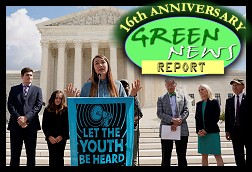 'Green News Report' 3/27/25
'Green News Report' 3/27/25
 Signal Scandal Worsens for Trump, GOP; Big Election Victories for Dems in PA: 'BradCast' 3/26/25
Signal Scandal Worsens for Trump, GOP; Big Election Victories for Dems in PA: 'BradCast' 3/26/25 'Emptywheel' on Why Trump NatSec Team Should 'Resign in Disgrace' After Signal Chat Debacle: 'BradCast' 3/25/25
'Emptywheel' on Why Trump NatSec Team Should 'Resign in Disgrace' After Signal Chat Debacle: 'BradCast' 3/25/25 'Green News Report' 3/25/25
'Green News Report' 3/25/25 Postal Workers Union Prez: USPS 'Belongs to the People, Not the Billionaires':
Postal Workers Union Prez: USPS 'Belongs to the People, Not the Billionaires':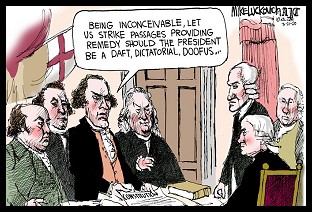 Sunday 'Suddenly Conceivable' Toons
Sunday 'Suddenly Conceivable' Toons We're ALL Voice of America Now: 'BradCast' 3/20/25
We're ALL Voice of America Now: 'BradCast' 3/20/25 'Green News Report' 3/20/25
'Green News Report' 3/20/25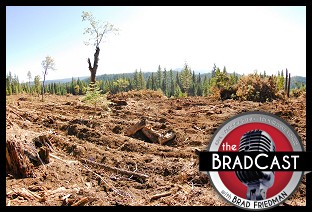 What Trump's 'Timber Production Expansion' Means (and Costs): 'BradCast' 3/19/25
What Trump's 'Timber Production Expansion' Means (and Costs): 'BradCast' 3/19/25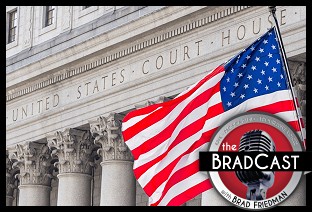 Courts Largely Holding Against Trump, Musk Lawlessness: 'BradCast' 3/18/25
Courts Largely Holding Against Trump, Musk Lawlessness: 'BradCast' 3/18/25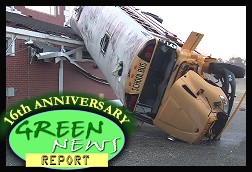 'Green News Report' 3/18/25
'Green News Report' 3/18/25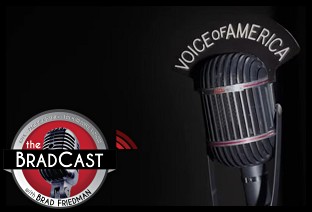 Chief VOA Reporter on Outlet Falling Silent First Time Since 1942: 'BradCast' 3/17/25
Chief VOA Reporter on Outlet Falling Silent First Time Since 1942: 'BradCast' 3/17/25 Sunday 'The Usual' Toons
Sunday 'The Usual' Toons 'Green News Report' 3/13/25
'Green News Report' 3/13/25 Trump EPA Unveils Plans to Endanger, Sicken Americans: 'BradCast' 3/13/25
Trump EPA Unveils Plans to Endanger, Sicken Americans: 'BradCast' 3/13/25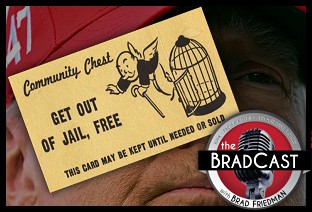 Trump Nixed Enforce-ment Against 100 Corp. Lawbreakers: 'BradCast' 3/12/25
Trump Nixed Enforce-ment Against 100 Corp. Lawbreakers: 'BradCast' 3/12/25 Bad Day for 'Strongmen': 'BradCast' 3/11
Bad Day for 'Strongmen': 'BradCast' 3/11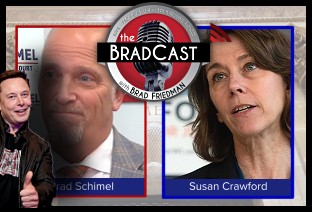 WI Election Could Flip Supreme Court Control, Musk Jumps In: 'BradCast' 3/10
WI Election Could Flip Supreme Court Control, Musk Jumps In: 'BradCast' 3/10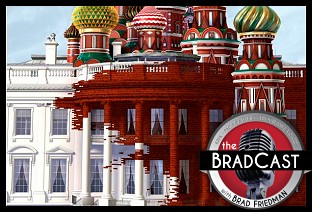 'What Else Could a Russian Asset Do That Trump Hasn't?': 'BradCast' 3/6/25
'What Else Could a Russian Asset Do That Trump Hasn't?': 'BradCast' 3/6/25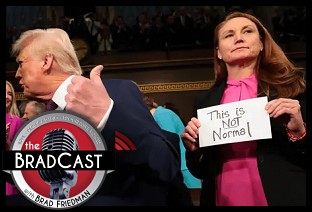 The Longest, Dullest, Most Lie-Filled 'SOTU' Ever: 'BradCast' 3/5/25
The Longest, Dullest, Most Lie-Filled 'SOTU' Ever: 'BradCast' 3/5/25 Trump Bad for Biz... and Farmers... and Nat'l Parks... and...: 'BradCast' 3/4/25
Trump Bad for Biz... and Farmers... and Nat'l Parks... and...: 'BradCast' 3/4/25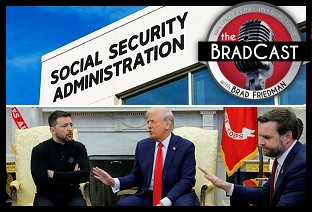 Trump Targeting 50% Cuts, Office Closures at Social Security: 'BradCast' 3/3/25
Trump Targeting 50% Cuts, Office Closures at Social Security: 'BradCast' 3/3/25
 VA GOP VOTER REG FRAUDSTER OFF HOOK
VA GOP VOTER REG FRAUDSTER OFF HOOK Criminal GOP Voter Registration Fraud Probe Expanding in VA
Criminal GOP Voter Registration Fraud Probe Expanding in VA DOJ PROBE SOUGHT AFTER VA ARREST
DOJ PROBE SOUGHT AFTER VA ARREST Arrest in VA: GOP Voter Reg Scandal Widens
Arrest in VA: GOP Voter Reg Scandal Widens ALL TOGETHER: ROVE, SPROUL, KOCHS, RNC
ALL TOGETHER: ROVE, SPROUL, KOCHS, RNC LATimes: RNC's 'Fired' Sproul Working for Repubs in 'as Many as 30 States'
LATimes: RNC's 'Fired' Sproul Working for Repubs in 'as Many as 30 States' 'Fired' Sproul Group 'Cloned', Still Working for Republicans in At Least 10 States
'Fired' Sproul Group 'Cloned', Still Working for Republicans in At Least 10 States FINALLY: FOX ON GOP REG FRAUD SCANDAL
FINALLY: FOX ON GOP REG FRAUD SCANDAL COLORADO FOLLOWS FLORIDA WITH GOP CRIMINAL INVESTIGATION
COLORADO FOLLOWS FLORIDA WITH GOP CRIMINAL INVESTIGATION CRIMINAL PROBE LAUNCHED INTO GOP VOTER REGISTRATION FRAUD SCANDAL IN FL
CRIMINAL PROBE LAUNCHED INTO GOP VOTER REGISTRATION FRAUD SCANDAL IN FL Brad Breaks PA Photo ID & GOP Registration Fraud Scandal News on Hartmann TV
Brad Breaks PA Photo ID & GOP Registration Fraud Scandal News on Hartmann TV  CAUGHT ON TAPE: COORDINATED NATIONWIDE GOP VOTER REG SCAM
CAUGHT ON TAPE: COORDINATED NATIONWIDE GOP VOTER REG SCAM CRIMINAL ELECTION FRAUD COMPLAINT FILED AGAINST GOP 'FRAUD' FIRM
CRIMINAL ELECTION FRAUD COMPLAINT FILED AGAINST GOP 'FRAUD' FIRM RICK SCOTT GETS ROLLED IN GOP REGISTRATION FRAUD SCANDAL
RICK SCOTT GETS ROLLED IN GOP REGISTRATION FRAUD SCANDAL VIDEO: Brad Breaks GOP Reg Fraud Scandal on Hartmann TV
VIDEO: Brad Breaks GOP Reg Fraud Scandal on Hartmann TV RNC FIRES NATIONAL VOTER REGISTRATION FIRM FOR FRAUD
RNC FIRES NATIONAL VOTER REGISTRATION FIRM FOR FRAUD EXCLUSIVE: Intvw w/ FL Official Who First Discovered GOP Reg Fraud
EXCLUSIVE: Intvw w/ FL Official Who First Discovered GOP Reg Fraud GOP REGISTRATION FRAUD FOUND IN FL
GOP REGISTRATION FRAUD FOUND IN FL


































